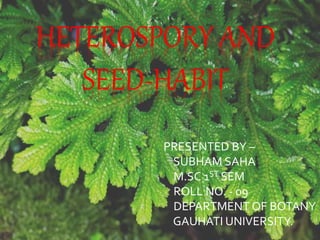
Heterospory and seed habit by Subham saha
- 1. HETEROSPORY AND SEED-HABIT PRESENTED BY – SUBHAM SAHA M.SC 1ST SEM ROLL NO. - 09 DEPARTMENT OF BOTANY GAUHATI UNIVERSITY.
- 2. CONTENT INTRODUCTION HETEROSPORY ORIGIN OF HETEROSPORY SIGNIFICANCE OF HETEROSPORY SEX DIFFERENTIATION SEED HABIT ORIGIN OF SEED HABIT CONCLUSION REFERENCE
- 3. INTRODUCTION There are some Pteridophytes which produce two different types of spores. Such Pteridophytes are known as heterosporous and the phenomenon is known as heterospory. Heterospory is considered as a pre-requisite of seed formation. According to Rashid (1976), only 8 living genera of Pteridophytes are heterosporous.
- 4. ORIGIN OF HETEROSPORY It is universally accepted that homosporous condition is primitive and heterospory is derived. The origin of heterospory can be better discussed on the basis of evidences from paleobotany, developmental and experimental studies. 1. Palaeobotanical evidences: It has been suggested that heterospory arose due to degeneration of some spores in a few sporangia. As more nutrition becomes available to less number of spores, the surviving spore grow better, hence increase in their size. Palaeobotanical evidences also shows that the heterosporous condition appeared subsequently in the lowermost upper Devonian.
- 5. According toWilliamson and Scot (1894), two species of Calamostachys form the initial stage that might lead to the heterospory.These species were C. binneyana and C. casheana. MICROSPORES MEGASPORES
- 6. 2. Evidences from Developmental Studies: In heterosporous Pteridophytes the development of micro and megasporangia follow the same pattern.They have identical organization but for their size. While in megasporangia most of the spore mother cells degenerate but in microsporangia only a few mother cells are disorganize The phenomenon of heterospory becomes distinct either before or after meiosis. In Selaginella, Isoetes it is distinct before meiosis. In Marsilea, Salvinia and Azolla the phenomenon of heterospory becomes distinct after meiosis
- 7. 3. Evidences from Experimental Studies: Experimental studies on Selaginella (Goebel, 1905) and Marsilea (Shattuck, 1910) suggest that nutritional factors mainly govern the heterospory. Under conditions of low light intensity, the photosynthetic activity of Selaginella was retarted and it produced microsporangia. By sudden lowering of the temperature, the size of the microspores in the sporocarp of Marsilea increases by six times.
- 9. SIGNIFICANCE OF HETEROSPORY The phenomenon of heterospory is of great biological significance on account of the following facts: (i)The development of the female gametophyte starts while the megaspore is still inside the megasporangium. (ii) Same is true of microspores i.e., they also start germinating into male gametophytes while they are still inside microsporangium. (iii)The female gametophyte derives its nourishment from the sporophyte i.e., female gametophyte is dependent on sporophyte for its nourishment. (iv)The dependence of female gametophyte on sporophyte for its nourishment provides better starting point for the development of new embryo than an independent green prothallus which has to manufacture its own food.
- 10. SEX DIFFERENTIATION In heterospory, the smaller spores i.e. microspores gives rise to microgametophyte bearing male sex organs. And, the larger spores i.e. magaspores develops into megagametophyte bearing female sex organs. It is quite clear that the differentiation in the size of the spore is directly related to the sex differentiation of the gametophytes. Therefore, heterospory is an expression of sex differentiation in plants.
- 11. Incipient heterospory is usually found in fossil plants where different sizes and sexes are found in same sporangium. But the size of the spores are not natural as they have to be in normal circumstances.
- 12. SEED HABIT IN PTERIDOPHYTES The adoption of heterospory and the retention and germination of a single megaspore within megasporangium to form a female gametophyte, led to the phenomenon of “seed habit”, a characteristic feature of the spermatophytes. ORIGIN OF SEED HABIT The origin of seed habit is associated with the following: (i) Production of two types of spores (heterospory). (ii) Reduction in the number of megaspores finally to one per megasporangium. (iii) Retention and germination of the megaspores and fertilization of the egg. (iv) Continued development of the fertilized egg into the embryo while still in situ.
- 13. From the above observations it is concluded that the life history of Selaginella approaches towards seed habit because of the following features: 1.The occurrence of the phenomenon of heterospory. 2. Germination of megaspore inside megasporangium. 3. Retention of megaspore inside megasporangium either till the formation of female gametophyte or even after fertilization.This condition can be linked with vivipary in some angiosperms. 4. Development of only one megaspore per megasporangium for example, in Selaginella monospora, S. rupestris, S. erythropus etc.
- 14. Though Selaginella as well as lower Spermatophytes shows homologies in their structure as follows: Selaginella: LowerSpermatophytes (Gymnosperms): 1. Megasporangium. 1. Nucellus of ovule. 2. Megaspore. 2. Megaspore(Embryosac). 3. Female gametophyte. 3. Endosperm. 4. Archegonium. 4. Archegonium. 5. Egg. 5. Egg.
- 15. Even then the seeds are not formed in Selaginella because: 1. Megasporangium is not surrounded by integument. 2.The retention of megaspore permanently inside the megasporangium has not been well established. 3.The embryo immediately gives rise to the sporophyte without undergoing a resting period.
- 16. CONCLUSION After considering the above conditions, we can conclude that there is a connecting link between heterosporous condition and formation of seed habit. It is quite possible that some biochemical compounds determine the sexual behaviors of spores. In homosporous spores, the hormones that govern the male and the female characters are balanced.When the process of degeneration starts, there will be imbalances leading to changes in sexual behavior. From the above discussions, it is clear that heterospory of Selaginella plays significant role in the development of seed-habit and finally from this seed-habit evolution of seed might have taken place in higher plants.
- 17. REFERENCES SOURCE : INTERNET https://www.alamy.com/studies-in-fossil-botany-paleobotany-calamostachys https://www.biologydiscussion.com/pteridophytes/heterospory-and-seed-habit https://www.google.com/search?q=seed+habit+in+selaginella https://www.easybiologyclass.com/heterospory-and-seed-habitat-in- pteridophytes SOURCE : BOOK Botany for degree students : Pteridophytes byVaisistha, kumar & Sinha. Studies in Botany volm. 1 by J.N.Mitra, Debabrata Mitra & SalilChowdhury.